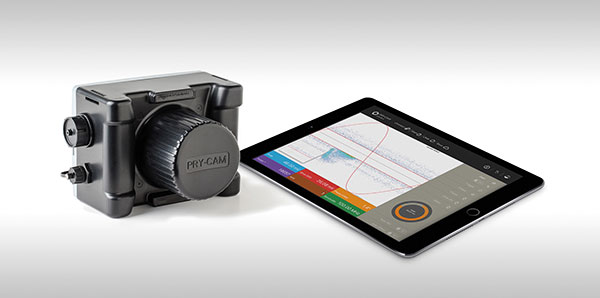A revolution in the management
of electrical assets
Innovation
A revolution in the management of electrical assets
Roberto Candela, Prysmian Electronics CEO, tells us more about PRY-CAM technology and products.

“With PRY-CAM, we are revolutionising electrical systems" diagnostics and monitoring, starting from Partial Discharge (PD) measurements – one of the key indicators of MV or HV cable systems reliability – up to a range of devices for the measurement of temperature and other parameters that, so far, could not be kept under control. Our solutions allow to assess the working conditions of any electrical system in real time and without service interruptions, thus generating a remarkable reduction in the risk of faults and related costs, and contributing to make maintenance activities less burdensome for our customers”.
THE ORIGINS
Prysmian Electronics originates from Prysmian Group’s will to establish an operative unit offering electronics-based products, designed, at least at an earlier stage, for the monitoring of power transmission cable systems. “The idea – explains Candela – has its roots in a patent, developed with a team of researchers in 2006, when I was a professor at the University of Palermo, for a device to detect PD in electrical systems”. In 2009, Prysmian acquired the intellectual property of the patent and in 2012 it created Prysmian Electronics, a fully integrated Group company that now has a turnover of € 15 million.
PRY-CAM AND THE WORLD OF DIAGNOSTICS

Originally, PRY-CAM identified only a portable camera-shaped device for PD measurements: PRY-CAM Portable. At a later stage, PRY-CAM started to evolve and identify a technology and a broader range of products. Today the acronym CAM also stands for Condition Assessment and Asset Management. “PRY-CAM – explains Candela – comes from the merge of the words Prysmian and Camera. The first product released looks like a camera, based on the concept that cameras are portable, high added-value objects, which maintain their value over time and allow to store the captured data and review them, whenever desired. Since then, we have released more devices and today we do not measure only PD, but also all electrical parameters, temperature, noises generated in the surroundings of cables and much more. For example, DTS (Distribute Temperature Sensor) allows temperature measurement along the entire route of a cable system to monitor its performances; DAS (Distributed Acoustic Sensor), allows to detect by ways of an acoustic sensor the presence in the vicinities of a cable of - for instance - an anchor that could damage it and to localize a possible fault”.
BIG DATA
PRY-CAM technology leverages three main features. First, it relies on outstanding performances in terms of sensitivity, precision, reliability and speed. Second, the fully integrated manufacturing of products within the Group makes them financially competitive. Third, and most important, is connectivity. A whole Cloud-based system is built around this technology and the connected devices can transfer entire sets of information to the Cloud for real time access. “Today our database hosts more than 1 million measurements that had never been classified and stored before we did it, ranging from condition of use, to malfunctioning and overheating, to name a few”, explains Candela. “Our mission is to gather and classify data for it to be analysed by automated diagnostics systems. In addition, our system can be used by anyone, regardless of their specific expertise, with data interpretation made extremely easy”.
COSTS AND SERVICES
PRY-CAM services prove to be cost-effective and its products fit perfectly with turn-key supply patterns. “I always like to make an example”, Candela says. “In the 80s, when you bought a new car, you would buy the audio device from a specialist retailer. Today, the car manufacturer’s website offers three or four different-priced audio system options, fully integrated into the cockpit and operated via the car’s entertainment system, regardless of their brand. The same thing happens with our products and our system is not only integrated, but it is also highly cost-effective. Furthermore, our end users have a single point of contact and do not face warranty issues. In addition to monitoring systems, we also provide analysis and periodic reporting service, with large TSOs now relying on our solution for this reason alone. That would have been impossible to imagine a few years ago.
FUTURE DEVELOPMENTS
“Our future focus will be mainly on PD measurements applied to Direct Current (DC), because this is where Prysmian Group is more active and the undisputed leader. As a matter of fact, in terms of diagnostics capabilities, we are the only ones who can offer this type of service.” Candela says. “We will focus also on taking another step to integrate our monitoring systems with cable systems: the new Smart Link-box”, he adds. Link-boxes have been existing for more than half a century, but so far, they have always been passive tools. They are steel boxes placed by each joint along the cable system’s route that host cable earthing connections and surge arresters, which play a key role in the case of lightning bolts or short circuits. Until a short time ago, whenever a fault occurred, the box had to be opened to make necessary checks and closed afterwards. “This activity should be carried out every six months but it’s a complicated operation – goes on Candela – and often it does not take place unless a fault occurs. With the integration inside the link box of monitoring devices capable of providing all functioning parameters, we avoid any invasive action. This delivers remarkable advantages in terms of real-time information gathering and maintenance planning. Our ultimate goal is to keep on integrating electronics within cables rather than outside, as it was in the past.”
